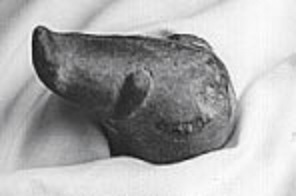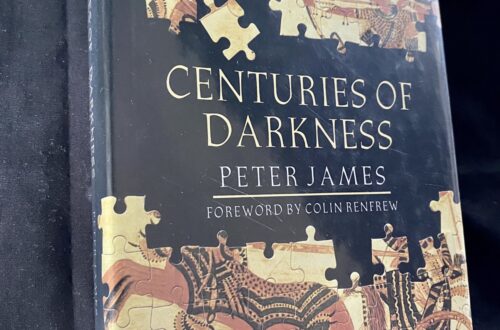
Fakes in Anatolia
James Stuart Mellaart and the Prehistory of Anatolia
James Mellaart was still a young man when he came to Turkey and there married a Turkish lady. His main occupation was archaeology. Around the year 1955 a vivid market for pretty prehistoric ceramic figurines flowered in the country, and Mellaart got active to find out the origin of the figurines. He finally located them near the village of Hacilar at lake Burdur. He bought as many of those statuettes as he could get hold of and in 1957 began excavating himself at the site. He thus unearthed a Neolithic and copper age settlement until 1960. Very few colleagues saw the excavated site, but they saw a number of beautiful drawings and photographs including good descriptions of the artifacts. At the end of the campaign, Mellaart covered the whole settlement again in order to protect the site from erosion. Nowadays nothing gives a hint to the excavation as I could personally discover when I visited the fields in 1966, guided by a local farmer who knew the exact location.
Yet figurines of the Hacilar type are still on sale there. I myself could buy a small head of a pig, “6000 years old” which has a long snout that suggests by its form the Neolithic art. Many of those figurines are now distributed through all the archaeological museums of the world testifying to the art and craftsmanship of the Anatolian Neolithic age.
In 1965 Peter Ucko in London started examining some of those ceramics and concluded from stylistic arguments that they must be forgeries. Six years later, in August 1971, British scientists published the outcome of their own examinations by way of thermoluminescence analysis: Of 66 Hacilar figurines held in museums 48 were beyond doubt modern falsifications.
First question was: Had Mellaart himself unearthed any figurines?
At least he had alleged it, and with such a statement Mellaart was definitely finished as an archaeologist. And the Hacilar culture had to be cancelled as well.
Now comes a surprise. Some years later this same professional Mellaart excavated another Neolithic settlement in Anatolia, famous Çatal Hüyük, where he found even more beautiful art pieces as well as wall paintings suggesting a centre of a high civilisation as old as Hacilar, at least 6000 years. But this underground settlement cannot be visited, either; we only have the marvellous figures and ceramics in the Museum of Ankara and distributed to a great number of institutions.
By restoring his reputation with this second discovery Mellaart has proved that he is an able archaeologist, and that Neolithic Anatolia was well worth its praise.
If there hadn’t been the Dorak affair which cast more doubt on his honesty. He himself told the story in two different versions; I resume the meagre facts from Dora Jane Hamblin (1973), who used Pearson und Connor (1968) as sources.
In 1958, one year after he had started excavating Hacilar, Mellaart dwelled for some time in Izmir (on the west coast of Anatolia) and there produced drawings of a royal treasure of Jortan culture, as whose origin he named the village Dorak in the vicinity of Troy. His drawings and scientific description were published in well known Illustrated London News (Nov. 28th, 1959) on several pages.
There we are confronted with a throne bearing Egyptian hieroglyphs pertaining to Pharaoh Sahure (“2400 BC”). This then is by far the oldest written record in the whole of Anatolia. To the treasure belong precious items such as rich golden jewellery, a chalice of obsidian, a silver dagger, figurines and even textile fragments. It is described as the inventory of a royal burial of the Jortan culture. The accompanying drawings are of excellent quality; Mellaart is a master of this art. Unluckily there exist no photographs of the findings, and the objects did not materialize anywhere. Nor is the site of the excavation known to anybody.
It is only Mellaart’s word which we have to trust.
If an archaeologist cannot discover a treasure he has to forge it, or – easier and better – just draw it.
 Head of an “archaic” pig from Hacelar (foto Uwe Topper)
Head of an “archaic” pig from Hacelar (foto Uwe Topper)
References
Hamblin, Dora Jane (1973): Türkei, Land der lebenden Legenden (USA, German 1977 und 1988, Lübbe, Berg. Gladbach)
Pearson, Kenneth, and Connor, Patricia (1968): The Dorak Affair (New York)
Published in German in EFODON-Synesis Nr. 53 (Sept./Oct. 2002), pp. 4–9
Latest news regarding Mellaart’s fraud: here in actualities18
The lies of Mellaart uncovered James Mellaart is postumously convicted of lifelong forgeries
Ilya Topper writes:
Yesterday I read in a Turkish newspaper a note which had been published some days ago in the English press (March 12th, 2018): James Mellaart has now been branded as trickster and counterfeiter by scrutinizing his legacy five years after his death:
All the wall drawings he excavated in Catalhoyuk (allegedly 9,000 years old) he had designed himself. Moreover, he operated archeological forgery until the end of his life (2012). In his last will he asked to publish after his death the Luwian inscriptions discovered by him, if it had not been possible before. It was only just recently in December 2017 that a successor and archeologist, Eberhard Zangger, by browsing Mellaart’s estate, found out that Mellaart had also written those inscriptions himself. This now he has indignantly hung on the big bell: Mellaart played that game for 50 years! The conclusion is that whatever Mellaart ever touched must be considered wrong, because if anything real should be there, it can not be separated from his inventions.
Of course, this does not surprise us (see above our contribution from 2002 “Fakes in Anatolia”), but it can provide us another fragment to the overall picture: The so often observed strategy of some counterfeiters that consists in publishing their inventions only after their death, when selfishness can be no more suspected to be the motivation. The experts are now asking why Mellaart did it.
Mellaart was accused of falsification already in 1965 by Peter Ucko using art stylistics, and in August 1971 by others in London using the Thermoluminescence method; so some experts since then knew about the desaster (see Hamblin). Likewise, Illig knew it also, in 1988.
Postscript: According to wikipedia, Mellaart taught Anatolian archeology from 1964 to 2005 at the Institute of Archeology of the University of London. The overall view of history for Anatolia set up by him is no longer to be extinguished, all archeologic information about this part of the world and time is completely abstruse.
Hamblin, Dora Jane (1973): Buried Cities and Ancient Treasures ( USA)
Pearson, Kenneth, und Connor, Patricia (1968): The Dorak Affair (New York)
Ilya Topper, March 23rd , 2018




